The realm of international football is perpetually in flux, and recent developments underscore a pattern of ambitious clubs reevaluating their strategies. Al Nassr’s pursuit of Christian Pulisic exemplifies how Middle Eastern teams are emerging as serious contenders on the transfer front. With the Saudi Pro League’s recent financial injection, clubs like Al Nassr are not just seeking marquee signings; they are attempting to assemble competitive squads that could rival traditional European giants. The organization’s interest in integrating players with proven international experience, such as Pulisic, highlights a shift toward acquiring talent that elevates league stature and attracts global attention.
Meanwhile, Real Madrid’s strategic scouting expands beyond familiar European terrains. The club’s interest in French defender Ibrahima Konaté emphasizes an ongoing quest for defensive solidity. Konaté’s rejection of Liverpool’s extension offer reveals a broader trend: top players are increasingly weighing financial incentives against long-term stability and club ambitions. With Madrid’s pressing need to bolster their backline following recent competitions, Konaté’s potential move signals a shift of power dynamics, indicating that elite clubs recognize the importance of securing emerging talents early.
Financial Fierceness and Negotiation Battles
Transfer negotiations are tests of valuation, patience, and strategic positioning. Bayern Munich’s refusal to meet Stuttgart’s €80 million asking price for Nick Woltemade demonstrates how big clubs set firm boundaries, emphasizing value over urgency. Similarly, Bayern’s ongoing interest in Liverpool’s Luis Díaz and RB Leipzig’s Xavi Simons reflects a broader pattern: elite teams are meticulously targeting next-generation stars, carefully balancing cap space and squad harmony.
Bayern’s interest in Sancho and Nkunku shows their intent to revamp their attacking options without rushing into rash decisions. Yet, the complex nature of these negotiations underlines how clubs prioritize long-term roster planning over quick fixes—a departure from the impulsive transfer frenzy of yesteryear. This strategic patience could ultimately lead to more sustainable squads capable of competing at the highest levels for years to come.
Furthermore, the burgeoning race for Victor Osimhen illustrates how forward-thinking clubs are willing to pay premium prices for proven goal scorers. Galatasaray’s €40 million offer with installments exemplifies the innovative financial solutions teams employ to land top talent, contrasting sharply with the rigid pay scales of traditional European powerhouses. This shift toward flexible payment models signifies a desire to remain competitive economically while upgrading team quality.
Rising Stars and the New Talent Pipeline
Emerging young talents continue to captivate markets and reshape expectations. The potential moves of players like Jadon Sancho, who remains subject to uncertain circumstances at Manchester United, and Luka Modric’s imminent signing with AC Milan, reflect the fluidity of the modern transfer market. Clubs now recognize that investing in experienced veterans can provide stability, while also betting on young prospects for future growth.
AC Milan’s strategic patience regarding Dusan Vlahovic’s situation with Juventus illustrates a sophisticated approach: waiting for the right moment to make a move rather than rushing into costly and potentially disruptive signings. Meanwhile, the interest in versatile defensive talents like Marc Casadó and Johan Bakayoko underscores an awareness that adaptable, dynamic players are essential in today’s fast-paced game—acquiring squad depth that can be tailored to tactical demands.
Youth development and scouting prowess are now integral to club success. Napoli’s approach to finalizing deals with Udinese and Bologna demonstrates a keen eye for promising talent ready for Italy’s top tier. The strategic negotiation over players like Lorenzo Lucca and Matías Fernández-Pardo indicates a nuanced understanding that today’s transfer success hinges not just on signing star names but on understanding player potential and fit.
Strategic Betting on Future Pedigree
In an era where data analytics and scouts’ intuition combine, clubs are making calculated risks on emerging players. Borussia Dortmund’s exploration of Johan Bakayoko’s potential adds to this pattern. Similarly, Chelsea’s loans and sales, such as Djordje Petrovic’s move to Bournemouth, reveal a long-term developmental philosophy—investments in youth often translate into future success elsewhere.
The importance of adaptable financial strategies is reflected in the negotiations surrounding high-profile signings like Rodrygo and others across Europe. The cost of acquiring proven talent remains high, but clubs are increasingly willing to absorb these expenses in hopes of gaining long-term dividends, whether through competition success or subsequent player resale.
Finally, the evolving transfer market is shaped by a desire to strike a balance between immediate impact and sustainable growth. The pursuit of versatile, ready-made stars, coupled with the scouting of raw talent, signifies a paradigm shift—clubs are no longer merely buying names but investing in future potential, long-term squad harmony, and competitive resilience.
The Future of Football Transfers
The current transfer landscape is characterized by strategic patience, financial innovation, and a focus on both immediate impact and long-term stability. As clubs across continents adopt more sophisticated approaches—balancing financial clout with tactical vision—the game is evolving into a chess match of intent and foresight.
Whether it’s the bold moves of Middle Eastern clubs, the relentless pursuit of European giants, or emerging markets looking to make their mark, one thing remains clear: modern football transfers are less about buying star power and more about building sustainable, competitive teams prepared for the future. This evolution heralds a new era where strategic planning and calculated risk-taking take precedence, shaping a game that is as much about vision and resilience as it is about raw talent.

Leave a Reply